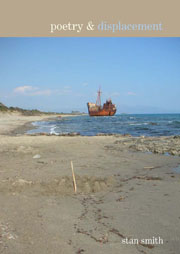Book contents
- Frontmatter
- Contents
- Acknowledgements
- 1 Introduction: Poetry, Place and Displacement
- 2 On the Edge of Things: Philip Larkin
- 3 A Double Man in a Double Place: Iain Crichton Smith
- 4 Salvaged from the Ruins: Ken Smith's Constellations
- 5 Lost Bearings: Christopher Middleton
- 6 ‘What Like Is It?’ Carol Ann Duffy's Différance
- 7 Darkening English: Post-imperial Contestations in Seamus Heaney and Derek Walcott
- 8 Living in History
- 9 An Age of Simulation: Tall Tales and Short Stories
- 10 Nowhere Anyone Would Like To Get To
- 11 Milking the Cow of the World: Displacement Displaced
- Notes
- Bibliography
- Index
9 - An Age of Simulation: Tall Tales and Short Stories
- Frontmatter
- Contents
- Acknowledgements
- 1 Introduction: Poetry, Place and Displacement
- 2 On the Edge of Things: Philip Larkin
- 3 A Double Man in a Double Place: Iain Crichton Smith
- 4 Salvaged from the Ruins: Ken Smith's Constellations
- 5 Lost Bearings: Christopher Middleton
- 6 ‘What Like Is It?’ Carol Ann Duffy's Différance
- 7 Darkening English: Post-imperial Contestations in Seamus Heaney and Derek Walcott
- 8 Living in History
- 9 An Age of Simulation: Tall Tales and Short Stories
- 10 Nowhere Anyone Would Like To Get To
- 11 Milking the Cow of the World: Displacement Displaced
- Notes
- Bibliography
- Index
Summary
Hyping ‘the real’
In his essay ‘Simulacra and Simulations’, Jean Baudrillard described the postmodern condition as one in which what was once regarded as ‘reality’, ‘the real’, had been permanently displaced into the virtual, to be constituted now only in the interminable play of signifiers which saturate contemporary experience. The essay deployed as its opening topos the Borgesian motif of a full-scale map laid over and completely coterminous with reality, ‘a map so detailed that it ends up exactly covering the territory’. Today, Baudrillard argued,
Simulation is no longer … of a territory, a referential being or a substance. It is the generation by models of a real without origin or reality: the hyperreal. The territory no longer precedes the map, nor survives it. Henceforth, it is the map that precedes the territory … it is the map that engenders the territory.… It is the real, and not the map, whose vestiges subsist here and there, in the deserts which are … our own. The desert of the real itself. (p. 167)
This is not entirely a new note in Western culture. To some extent it reruns, in a more fashionable idiom, that myth of the Fall which, in an earlier dispensation, emerged as T. S. Eliot's ‘dissociation of sensibility’, the mysterious schism between belief and fact which, according to Eliot, set in in the middle of the seventeenth century.
- Type
- Chapter
- Information
- Poetryand Displacement , pp. 155 - 172Publisher: Liverpool University PressPrint publication year: 2007



